Some of you know that I recently went back to America during part of summer vacation. While I was in Los Angeles, my friend Worm (it’s a nickname, don’t ask) was kind enough to take me up to see the Southern Wing of the Commemorative Air Force (CAF) at Camarillo Airport where he volunteers as a pilot. The CAF is a completely volunteer-run non-profit that restores and flies military aircraft – primarily WWII aircraft. Though the United States produced over 300,000 aircraft during the Second World War, almost none remained by 1960. Now, the CAF holds nearly 160 aircraft (60 different types) in various locations across the United States. The fleet includes aircraft from several different countries and aircraft from conflicts since WWII.
The CAF defines their mission as:
The CAF was founded to acquire, restore and preserve in flying condition a complete collection of combat aircraft which were flown by all military services of the United States, and selected aircraft of other nations, for the education and enjoyment of present and future generations of Americans.
More than just a collection of airworthy warplanes from the past, the CAF’s fleet of historic aircraft, known as the CAF Ghost Squadron, recreate, remind and reinforce the lessons learned from the defining moments in American military aviation history.
The CAF travels internationally to hold educational exhibitions and perform air shows. The Southern California Wing of the CAF sports a ridiculously impressive collection of aircraft –
- Grumman F-8F Bearcat, N7825C – Flying
North American SNJ-5 Texan, N89014 – Flying
Grumman F6F-5 Hellcat, N1078Z – Flying
Mitsubishi A6M3 Zero, Model 22, N712Z – Flying
Fairchild PT-19 Cornell, N641BP – Flying
North American SNJ-4 Texan, N6411D – In restoration
Curtiss C-46, China Doll, N53594 – In restoration
North American B-25 Mitchell, N5865V – In restoration
Supermarine Mark XiV Spitfire, N749DP – In restoration
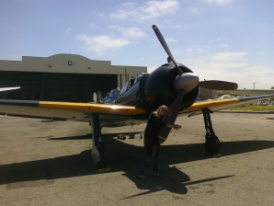 Obviously, I consider the Mitsubishi A6M3 ‘Zero’ to be the crown jewel of their collection. It has been completely restored and it is ONE OF ONLY THREE FLYABLE ZEROS IN THE WORLD. Because Worm is currently being groomed as the Zero’s new pilot, I got to crawl all over the damn thing.
Obviously, I consider the Mitsubishi A6M3 ‘Zero’ to be the crown jewel of their collection. It has been completely restored and it is ONE OF ONLY THREE FLYABLE ZEROS IN THE WORLD. Because Worm is currently being groomed as the Zero’s new pilot, I got to crawl all over the damn thing.
For WWII history buffs, the Zero has acquired an almost mythic reputation. I would argue that its silhouette is THE most recognizable of any WWII aircraft. No one can forget the images of Zeros flying over Pearl Harbor…even if it was a short clip from high school US History class or the images from Michael Bay’s atrocious Pearl Harbor (2001).
Picture Constantine having a history orgasm in the middle of an airstrip in SoCal and you’ll have a good idea of how excited I was.
The Zero was arguably the best carrier-based fighter during WWII, with a maneuverability and range that repeatedly devastated US fighters in dogfights during the early years of the Pacific conflict (especially considering the out-dated equipment that the US was using during 1941). By 1942-1943, however, an improvement in US equipment and tactics undermined the Zero’s ability to hold its own against the US military-industrial machine.
The Model 22 Zero at the SoCal CAF is not the model that was used during the attack on Pearl Harbor. The A6M3 Type 0 Model 22 (零式艦上戦闘機二二型) was produced between December 1942 and summer of 1943. It’s sports a new version of the Model 21’s longer folding wings, a more powerful engine and the longest range of all the Zeros. 560 Model 22s were produced.
To give you an idea of how rare the Zero is – the epic 1970 film Tora! Tora! Tora! (and most film and TV productions) use modified and repainted t-6 Texans. Only one Model 52 was used during the production of Bay’s Pearl Harbor.
Worm and some of the awesome men at the CAF explained to me that the Zero possessed maneuverability, speed and firepower at the expense of protection. There is only one small armor plate behind the cockpit that would do very little to protect the pilot. In contrast, American-built fighters had large amounts of armor plating, which protected the pilots at the expense of weight, maneuverability and speed. Comparing the planes up close, the Zero is absolutely dwarfed by the formidable Grumman F6F-5 Hellcat. One of the pilots ironically described the Zero’s construction as ‘chintzy’ and, indeed, there are large square areas on the Zero’s wings that you must avoid putting any weight on because of the thin metal. But this, too, speaks to the Zero’s efficiency as a carrier-based fighter.
Now for some orgasm worthy pictures (not great quality):
I was also happy to see the P-51 Mustang, complete with a Nazi death count on its side.
I was exceedingly lucky because the CAF were in the process of getting all the WWII aircraft ready for an airshow at a nearby naval base. I therefore got to watch a whole slew of aircraft – including the Zero – take off and fly away in formation. You, readers, are unlucky because I forgot to bring my camera and capture it all on film for you. Better luck next time!
I can honestly say that I would move to LA just to have the opportunity to volunteer at the SoCal CAF and drool over WWII planes (and veterans…and pilots…and Worm) on a regular basis.
For more information:
The CAF Southern California Wing – http://www.cafsocal.com/
The CAF Official Homepage – http://commemorativeairforce.org/
 Back in April/May, my mother came to visit me in Japan. During our trip down to Osaka, we took a ‘little’ detour into the nearby Wakayama-ken. Our destination: Koyasan (高野山). Founded in 819 by the monk Kukai (AKA Kobo Daishi), Koyasan is the world headquarters of the Koyasan Shingon sect of Buddhism. Home to approximately 120 temples, Koyasan is definitely a place where monks outnumber lay-people.
Back in April/May, my mother came to visit me in Japan. During our trip down to Osaka, we took a ‘little’ detour into the nearby Wakayama-ken. Our destination: Koyasan (高野山). Founded in 819 by the monk Kukai (AKA Kobo Daishi), Koyasan is the world headquarters of the Koyasan Shingon sect of Buddhism. Home to approximately 120 temples, Koyasan is definitely a place where monks outnumber lay-people.
My mother is fascinated with monks and Japanese Buddhism, so Koyasan was a definite MUST during her trip. For her, I think both fall clearly into the ‘Oriental Mystique’ category. Personally, my image of monks is based almost entirely on my knowledge of the Heian period of Japanese history. Specifically, when I think ‘monk’ I think of two things – the Heike Monogatari and The Teeth and Claws of the Buddha by Mikael Adolphson. The Heian period ended in 1185 and ‘sohei’ (warrior monks) have pretty much been extinct since Nobunaga set fire to Enryaku-ji back in 1571, so it’s safe to say that my knowledge of monks is a bit outdated. What can I say, I love living in the past.
Despite our combined ignorance, we were both interested in doing a ‘temple stay’ – where you stay in one of the local Buddhism temples and can enjoy some shojin ryori or ‘devotion food.’ (It’s all vegetarian, of course.) Little did we know that our trip to Koyasan would coincide with one of their most important ceremonies – the Kenchien Kanjo.
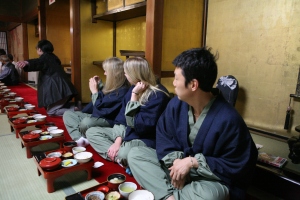 After we settled into our room at the Sekisho-in, some friendly monks ushered us out the door and ordered us to immediately head to the Garan. We followed a mass of Buddhist pilgrims clad in white and weilding votive candles down a gravel path illuminated by lanterns. The tree-lined path opened up to reveal an impressive orange-and-white pagoda. While monks bustled back and forth, the spring air was filled with chanting.
After we settled into our room at the Sekisho-in, some friendly monks ushered us out the door and ordered us to immediately head to the Garan. We followed a mass of Buddhist pilgrims clad in white and weilding votive candles down a gravel path illuminated by lanterns. The tree-lined path opened up to reveal an impressive orange-and-white pagoda. While monks bustled back and forth, the spring air was filled with chanting.
Further up the path lay the Kondo, a massive wooden structure that was originally built by Kobo Daishi in 819 (it has subsequently been rebuilt 7 times, probably due to fires).
The Kechien Kanjo is a Buddhist ritual where the blindfolded participant throws a flower into the Taizokai (Womb of the World Mandala) to establish a link between the participant and one of the emanation forms of Dainichi Nyorai. Afterward, water is used to wash away all worldly desires. On the first day, a procession of monks in colorful brocade robes called the Teigi Dai-Mandala0ku is held.
Day One in Koyasan –
Day Two:
How to Get There:
From Osaka’s NAMBA STATION take the NANKAI KOYA LINE to GOKURAKUBASHI STATION. From there, board the cable car for a brief ride to KOYASAN STATION at the top of the mountain. From Koyasan station, take the bus (there’s only one) to the town center.
Nankai Railways actually offers a KOYASAN WORLD HERITAGE ticket. This pass includes a round trip ticket to Koyasan from Namba Station, unlimited travel on the buses in Koyasan, and discount admission to certain attractions in Koyasan. The pass is valid for two consecutive days. The Regular version will cost you 2,780 per person and the Limited Express version is 3,310 per person.
Yesterday, I braved the crowds at Asakusa’s Senso-ji temple to witness a time honored Japanese tradition – shaking babies. No, I don’t mean the sort of behavior that results in Shaken Baby Syndrome, but the infinitely more entertaining one type that involves young sumo wrestlers.
Every year on the 4th Sunday of April, Senso-ji Temple at Asakusa holds a nakizumo festival, where young sumo wrestlers stand in a traditional sumo ring and compete to see who can make a baby cry the loudest and longest. A referee watches and yells, “Nake nake nake! (Cry, cry, cry!)” until finally declaring one baby the winner. The cries of the babies are supposed to bring good fortune to the children and drive away evil spirits. This type of festival is held in a various locations around Japan…in Asakusa, it has been going on for 400 years.
I was a little disappointed that they didn’t recruit full-grown sumo wrestlers to scare the kids into crying, I would have loved to see a big sumo wrestler holding a tiny baby. Instead, we got two sumo-wrestlers-in-training. Neither one of them looked much older than 15 to me. It was quite entertaining to watch these two chibi-sumos try to make the babies cry – one was fond of throwing the kids into the air (which they seemed to enjoy more times than not) while the other was trying to be very nice to the babies (which only seemed to make then cry harder). That’s babies for you, fickle creatures indeed.
When neither of the sumos could make a baby cry, the judges busted out some silly plastic oni (demon) masks and wore them in front of the babies – which made the audience burst out into laughter and the kids burst out into tears. Can anyone say, ‘Traumatized for life’?
About a 30 minute train ride outside of Tokyo is the city of Kawasaki, a typical Japanese suburb that sports a large train station/depaato and many neon-clad pachinko parlors. Every year on the first Sunday of April, Kawasaki is invaded by a flood of gaijin, Tokyo’s LGBT community, and curious onlookers to participate in (or just scratch their heads at) the Kanamara matsuri, the Iron Penis Festival. Each year, the Wakamiya Hachiman-gū Shrine (若宮八幡宮) parades Kanamara-sama, an iron phallus over 3 feet tall, around the streets near the shrine. Wakamiya Hachiman-gū Shrine is a Shinto fertility shrine and hosts a plethora of penis-shaped objects in various places around their grounds.
According to an old legend, a demon fell in love with a beautiful (but relentlessly pure) young virgin. Upon hearing of her engagement to a young man, the spiteful demon crawled up inside her and proceeded to bite off the penises of both her first and second husbands when they tried to ‘seal the deal.’ Logically, the best solution was for the people of the village to make an iron phallus to deflower the girl. Upon chomping down on the metal penis, the demon broke his teeth and evacuated the girl’s vagina.
Oddly enough, this story reminds me of a Tanith Lee short story called ‘The Weasel Bride’ from her collection Book of the Dead which I read, I kid you not, when I was 12 years old. Guess that’s what I get for liking to read unicorn books. Upon googling this short story, I discovered that this legend seems to reappear in a variety of cultures, not just Japan. Is this just an expression of male castration anxiety (ala Freud), intimidation of the all-consuming female vagina, or was there actually a sub-species of women with toothy vaginas that became extinct (presumably due to the troubles associated with procreation)?
I heard about this festival from my friend Bluesheeft, who attended it last year. Not wanting to pass up the opportunity to observe this festival myself, I headed out to Kawasaki yesterday with my friends 7thwave42, TheDutchGaijin (fresh off the boat from the Netherlands), and of course Bluesheeft and his mother (it’s not what it sounds like). I thought that this event must be fairly unique, but after mentioning it to several Japanese people they informed me that this sort of event is fairly common in the rural areas of Japan.
Of course, we were treated to many drunk people (foreign and Japanese), a Japanese surf/rockabilly band, and plenty of girls sucking on penis-shaped candy and having their photos snapped by sketchy Japanese men and their high-tech cameras. So, this is what those creepy guys ogling telescopic lenses at Yodobashi Camera do on the weekends.
I had a drunk old Japanese man fondle my hand and tell me that I should go and pray to Kanamara-sama in order to thank him for making men ‘genki,’ particularly Bluesheeft, who he assumed was my boyfriend. At least, I think that is what he said. I only understand 50% of what people say to me in Japanese and when alcohol gets thrown into the mix that number significantly decreases. I then had a run in with a bitchy peroxide blonde touting massive cleavage and penis candy who thought I disapproved of her amateur porn star photo shoots. I honestly didn’t and this only reinforced my fear of women. They are scary, scary creatures with claws. I also saw enough drunk American men running around the festival to make me renounce my nationality and claim I came from Canada.
If you are in Tokyo next April and want to experience something interesting, I highly recommend you check out the Kawasaki Iron Penis Festival.
How to Get There: The easiest way is to take the Keikyū Daishi Line (京急大師線) from Shinagawa Station (easily accessed by the JR Yamanote Line) to Kawasaki Daishi Station. This will place you right by the Wakamiya Hachiman-gū Shrine, which hosts the Kanamara matsuri.
We went rock climbing yesterday on Montezuma’s Tower (5.7) in Garden of the Gods. I’ve talked about this climb in an earlier blog entry, but this time I have video!
So, I condensed some of my videos from a roadtrip I took with my friend Scott this summer. I’ve been having some really f’ing annoying issues with editing videos lately, so low and behold the video is all tiny. But I give up!
We visited a flooded reservoir in Arkansas, hit up some local bar (a truly surreal experience), and spent a drunken weekend golfing in Nebraska. We also went to some cool rock climbing spots in the area, including Sam’s Throne, Arkansas and Keysinger Bluffs in Missouri.
The crag is a mix between bolted sport climbing and trad climbing. A cool feature is bungy cords that run from the bottom of the routes up to the anchor. You can tie your rope to the cord (with a clove hitch) and pull it up and through the anchor instead of having to lead climb. It took Hide and I a while to figure out this system and I found it a bit frustrating (you have to be a little bit creative at getting the rope through the anchor) but it is certainly good to have. The rock was pretty smooth and I thought the routes were sandbagged, but all in all we had a great day rock climbing. Fortunately, the wall was in the shade all day, so the temperature was really nice up there.
Mokuleia is also right by a state park and the beach there is beautiful. I saw a sea turtle swimming in the water, which totally made my day.


Some other cool Japanese places we visited were:The Izumo Taishakyo Mission in Chinatown (on S. Kukui St.) which is a Shinto shrine. Hide and I recieved our New Year ‘evil-demon-banishment’ from a Shinto preist wielding a wooden stick with sacred Shinto paper (silly description I KNOW) and some sake from miko (the girls who help out a Shinto temples whereing red hakama pants…they are traditionally supposed to be virgins).
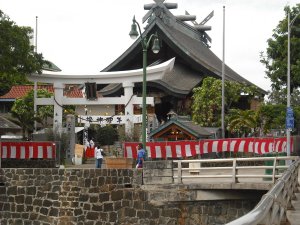
We also stopped by the Shirokiya Department Store (in the Ala Moana Mall) numerous times for Japanese manga (Hide was soothing his addiction for MDP Psycho and North Star Ken) and bobba smoothies. This is a great place to get lots of fun Japanese things, from cheap used Japanese books to baked goods. The upper floor has a Japanese food court with pretty authentic tako-yaki (octopus balls…Hide, the whiny Osakan gives it his seal of approval), mochi balls, mochi ice cream, gyoza, bento, etc etc. It is a little expensive though. If you want to get some inexpensive Japanese dishes and other household goods (even geta), then I recommend you go down to the Ward shopping center (it’s very close by) and check out the Wa-Raku import store located within the dollar store. It’s full of fun stuff.
If you need to itch your nerdy side, go to Toys N Joys (3632 Waialae Ave.), a cool local anime and collectible shop. This place has everything for premade cosplay outfits, to plushies, to moe girl figures. I had fun looking at all their cool stuff.
Finally, if you find yourself by the North Shore, Frommer’s and Lonely Planet will tell you to stop by Matsumoto’s in Haleiwa for some shave ice. This little store is very popular among Japanese tourists for shave ice (which is a slightly less crappy version of a snow cone). Those silly Japanese will stand in lines 20 people deep for the stuff. I’d recommend walking ten steps to the left and getting shave ice (exactly the same I SWEAR) from Aoki’s Shave Ice Stand. It also has a Japanese name, so it’s ok to substitute.
Hide and I went a little crazy for lychee bobba smoothies while we were in O’ahu. We had it in Chinatown, in Shirokiya, at a Korean BBQ place, and in Zagu’s (a local bobba stand in the Ala Moana shopping mall). There is a slight chance we had a little too much sugar. I am also eating Japanese mochi balls (a Japanese sweet made of pounded rice).
One of the more popular places to visit on O’ahu is the Dole Plantation located in the middle of the island. The former pineapple plantation has been transformed into a tourist trap and is a good place to take kids (any little boy would freak over the train they have) but it seems to be a popular place for Japanese, Korean, and Tawainese tourists as well. Pinnapples be damned, I wanted to there for the giant hedge maze they have, which was listed as the 2001 World’s Largest Maze by Guiness. In truth, I just wanted to run around a maze saying ‘Redrum’ and pretending to be a freaky child-ghost…but the maze wasn’t SO big that you’d could get lost in it (or escape from your murderous and possibly demonically possessed father). Instead of fleeing for our lives, Hide and I had to content ourselves with traveling to various checkpoints and stamping a piece of paper. This was made easier and less frustrating by a little map they give you of the maze when you enter. It was definitely hot and we celebrated our completion of the maze by having some pineapple treats – pineapple soft serve ice cream and a pineapple float. All-in-all, I think the Dole Plantation is a fun place to stop by and is right on the way to the North Shore. The maze costs $6.00 per adult and $4.00 per child, but you can find a ‘buy one ticket, get one free’ in some of the many attraction magazines found all over the island…so look for one! The plantation is right on the Kamehameha highway and impossible to miss. There are also some educational tours about the plantation, if you’re the sort of person who likes to have the imperialist history of the United States and Dole’s exertion of power over the Hawaiian royal family sugar-coated and shoved down your throat. If not, just check out the maze and HUGE giftshop.








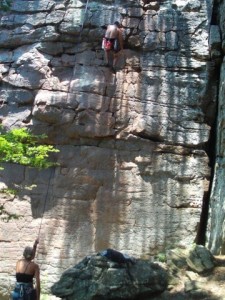
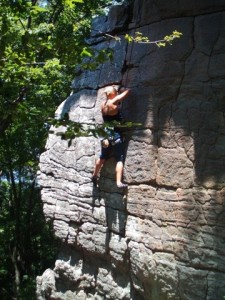


Recent Comments